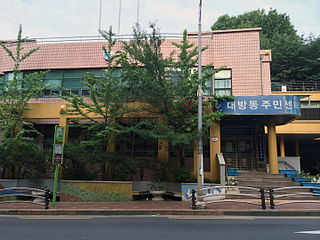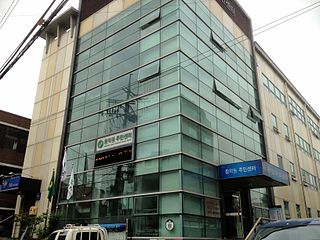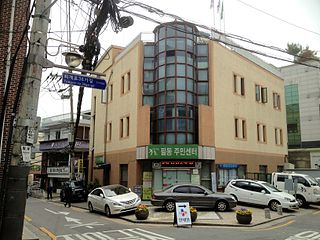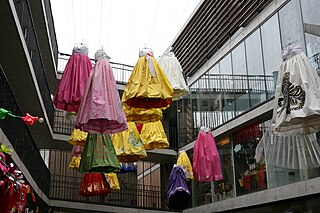Related Research Articles

Yeongdeungpo District is an administrative district in southwest Seoul, South Korea. Although the origin of the name is uncertain, the first two syllables are thought to be from "yeongdeung" (靈登) or "divine ascent", a shamanic rite. The third syllable is "po", representing the bank of a river (浦), referring to the district's position on the Han River. The 2006 population was 408,819.

Nam District is a gu, or district, in south-central Busan, South Korea. Much of Nam-gu sticks out into the Sea of Japan, forming a peninsula which separates Suyeong Bay from Busan Harbor. It has an area of 25.91 km2. Nam-gu officially became a gu of Busan in 1975. In 1995 part of Nam-gu was divided to form Suyeong-gu.
Yu Seong-won was a scholar-official of the early Joseon Dynasty, who is remembered as one of the six murdered ministers. He was born to a yangban family of the Munhwa Ryu lineage, but his date of birth is not known.

Gwanak District is an administrative subdivision (gu) of Seoul, South Korea. It lies on the southern skirt of Seoul, bordering Anyang of Gyeonggi Province. The southern border of Gwanak District, bordering Anyang, consists of the craggy ridgeline of Gwanaksan, which dominates the local geography.

Dongjak District (Korean: 동작구) is one of the 25 gu (districts) that make up the city of Seoul, South Korea. Its name was derived from the Dongjaegi Naruteo Ferry, on the Han River which borders the district to the north. It was the 17th gu created in Seoul, after being separated from Gwanak District on 1 April 1980.

Noryangjin Station (Korean: 노량진역) is a metro station in southwest region of Seoul, South Korea. The station is located in the Noryangjin-dong (neighborhood) of Dongjak-gu (ward) and is also a stop on Seoul Subway Line 1 and Seoul Subway Line 9. This stop is a popular destination for those seeking to eat raw fish, and other assorted seafood, as a large, covered sea food market is located next to the station, accessible by foot bridge. The Line 1 station is also notable in that Exit 1 and 2 have the same number as Exit 1 and 2 of Line 9's station.
Bon-dong is a dong (neighborhood) of Dongjak District, Seoul, South Korea.

Daebang-dong is a dong (neighborhood) of Dongjak District, Seoul, South Korea.
Dongjak-dong is a dong (neighborhood) of Dongjak District, Seoul, South Korea.

Sadang-dong is a dong (neighborhood) of Dongjak-gu in Seoul, South Korea.
Sangdo-dong (Korean: 상도동) is a dong, neighbourhood of Dongjak District in Seoul, South Korea.
Sindaebang-dong is a dong, neighbourhood of Dongjak-gu in Seoul, South Korea.

Changsin-dong is a dong (neighborhood) of Jongno District, Seoul, South Korea.

Noryangjin Fisheries Wholesale Market or shortly Noryangjin Fish Market is an extensive farmers fish market in the neighborhood of Noryangjin-dong in Dongjak District, Seoul, South Korea. It is located east of 63 Building, and just south of the Han River. Metro line 1 passes through at Noryangin station near-by. Exit the station at exit 1 and walk under the bridge. It is open 24/7.

Hwanghak-dong is a dong (neighborhood) of Jung District, Seoul, South Korea.

Pil-dong is a dong, neighbourhood of Jung-gu in Seoul, South Korea.

Seoul, the capital of South Korea, has many shopping areas and markets throughout the city. Famous ones include Myeong-dong, Cheongdam-dong, the Hongdae area, and the Dongdaemun and Namdaemun markets.
Nagwon-dong is a dong, neighbourhood of Jongno-gu in Seoul, South Korea. Nagwon means "paradise" in Korean. It is a legal dong administered under its administrative dong, Jongno 1, 2, 3, 4 ga-dong.
Siheung County, alternatively Shihŭng County was a county (gun) in Gyeonggi Province, South Korea. This county was abolished in 1989 as its one town(읍) of Sorae and two townships(면) of Gunja and Suam became Siheung City at the same time. Today's Siheung City area did not belong to Siheung County before 1914. The area rather was part of old Incheon or Ansan.
Retailing in South Korea consists of hypermarkets, department stores, flea markets, traditional markets, and underground shopping malls. Hypermarkets sell dry goods and groceries, similar to Western supercentres. Traditional markets are also popular throughout South Korea.
References
- 1 2 "노량진동 (Noryangjin-dong 鷺梁津洞)" (in Korean). Doosan Encyclopedia . Retrieved 2008-04-17.[ permanent dead link ]
- ↑ "Noryangjin Fisheries Wholesale Market (노량진수산물도매시장)". visitkorea.or.kr. Korea Tourism Organization.
